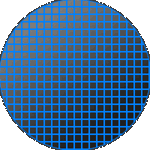COST OF PRODUCING DIGITAL SENSORS
The cost of a digital sensor rises dramatically as its area increases. This means that a sensor with twice the area will cost more than twice as much, so you are effectively paying more per unit "sensor real estate" as you move to larger sizes.
Silicon Wafer
(divided into small sensors)
Silicon Wafer
(divided into large sensors)
One can understand this by looking at how manufacturers make their digital sensors. Each sensor is cut from a larger sheet of silicon material called a wafer, which may contain thousands of individual chips. Each wafer is extremely expensive (thousands of dollars), therefore fewer chips per wafer result in a much higher cost per chip. Furthermore, the chance of an irreparable defect (too many hot pixels or otherwise) ending up in a given sensor increases with sensor area, therefore the percentage of usable sensors goes down with increasing sensor area (yield per wafer). Assuming these factors (chips per wafer and yield) are most important, costs increase proportional to the square of sensor area (a sensor 2X as big costs 4X as much). Real-world manufacturing has a more complicated size versus cost relationship, but this gives you an idea of skyrocketing costs.
This is not to say though that certain sized sensors will always be prohibitively expensive; their price may eventually drop, but the relative cost of a larger sensor is likely to remain significantly more expensive (per unit area) when compared to some smaller size.





![[No title]](/data/xfmg/thumbnail/36/36393-86ce601930c671b92b6df002b7fcbd0b.jpg?1734168775)
![[No title]](/data/xfmg/thumbnail/33/33447-c3f5563c9b8b1f19498a3062f60f92b1.jpg?1734163486)







